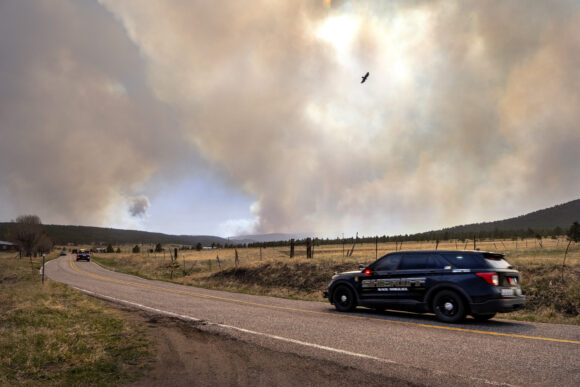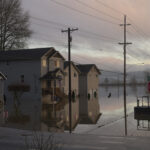SANTA FE, N.M. (AP) — New Mexico Gov. Michelle Lujan Grisham has signed emergency declarations as 20 wildfires continued to burn Sunday in nearly half of the state’s drought-stricken 33 counties.
One wildfire in northern New Mexico that started April 6 merged with a newer fire Saturday to form the second-largest blaze in the state at more than 66 square miles (171 square kilometers), leading to widespread evacuations in Mora and San Miguel counties.
Another wind-driven wildfire in northern New Mexico that began April 17 has charred at least 76 square miles (197 square kilometers) of ponderosa pine, oak brush and grass north of Ocate, an unincorporated community in Mora County.
Meanwhile in Arizona, some residents forced to evacuate due to a wildfire near Flagstaff were allowed to return home Sunday morning.
Winds and temperatures in New Mexico diminished Saturday but remained strong enough to still fan fires. Dozens of evacuation orders remained in place.
Fire officials were expecting the northern wildfires to slow Sunday as cloud and smoke cover moves in, allowing the forests to retain more moisture. But they added that the interior portions of the fires could show moderate to extreme behavior, which could threaten structures in those areas.
More than 200 structures have been charred by the wildfires thus far and an additional 900 remain threatened, Lujan Grisham said.
Fire management officials said an exact damage count was unclear because it’s still too dangerous for crews to go in and look at all the homes that have been lost.
“We do not know the magnitude of the structure loss. We don’t even know the areas where most homes made it through the fire, where homes haven’t been damaged or anything like that,” said operation sections chief Jayson Coil.
Some 1,000 firefighters were battling the wildfires across New Mexico, which already has secured about $3 million in grants to help with the fires.
Lujan Grisham said she has asked the White House for more federal resources and she’s calling for a ban of fireworks statewide.
“We need more federal bodies for firefighting, fire mitigation, public safety support on the ground in New Mexico,” she said. “It’s going to be a tough summer. So that’s why we are banning fires. And that is why on Monday I will be asking every local government to be thinking about ways to ban the sales of fireworks.”
Wildfire has become a year-round threat in the West given changing conditions that include earlier snowmelt and rain coming later in the fall, scientist have said. The problems have been exacerbated by decades of fire suppression and poor management along with a more than 20-year megadrought that studies link to human-caused climate change.
In Arizona, two large wildfires continued to burn Sunday 10 miles (16 kilometers) south of Prescott and 14 miles (22 kilometers) northeast of Flagstaff.
Coconino County authorities lifted the evacuation order Sunday morning for residents living in neighborhoods along Highway 89 after fire management officials determined the Flagstaff-area wildfire no longer posed a threat.
The fire near Flagstaff was at 32 square miles (83 square kilometers) as of Saturday night. It forced the evacuation of 766 homes and burned down 30 homes and two dozen other structures since it began a week ago, according to county authorities.
Arizona Gov. Doug Ducey declared the fire a state of emergency Friday for Coconino County to free up recovery aid to affected communities.
The wildfire near Prescott began last Monday and was at 4.8 square miles (12.4 square kilometers) and 15% contained as of Sunday morning as helicopters and air tankers dropped water and retardant to slow the fire’s growth.
The cause of the wildfires in New Mexico and Arizona remain under investigation.
About the photo: San Miguel County Sheriff’s Officers patrol N.M. 94 near Penasco Blanco, N.M. as the Calf Fire burns near by Friday, April 22, 2022. Destructive Southwest fires have burned dozens of homes in northern Arizona and put numerous small villages in New Mexico in the path of danger, as wind-fueled flames chewed up wide swaths of tinder dry forest and grassland and towering plumes of smoke filled the sky. (Eddie Moore/The Albuquerque Journal via AP)
Was this article valuable?
Here are more articles you may enjoy.


 Pacific Northwest Braces for Even More Flooding Rain This Week
Pacific Northwest Braces for Even More Flooding Rain This Week  Abbott Presses Congress for Shield Over Preemie Baby Formula Litigation That Could Cost It Billions
Abbott Presses Congress for Shield Over Preemie Baby Formula Litigation That Could Cost It Billions  Zillow Deleting Climate Risk Scores Reveals Limits of Flood, Fire Data
Zillow Deleting Climate Risk Scores Reveals Limits of Flood, Fire Data  Trump Sues BBC for $10 Billion Over Documentary Edit
Trump Sues BBC for $10 Billion Over Documentary Edit 